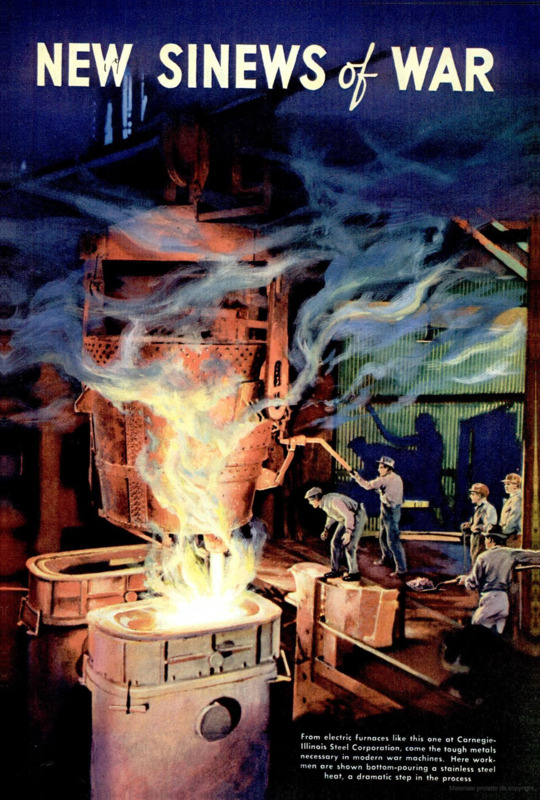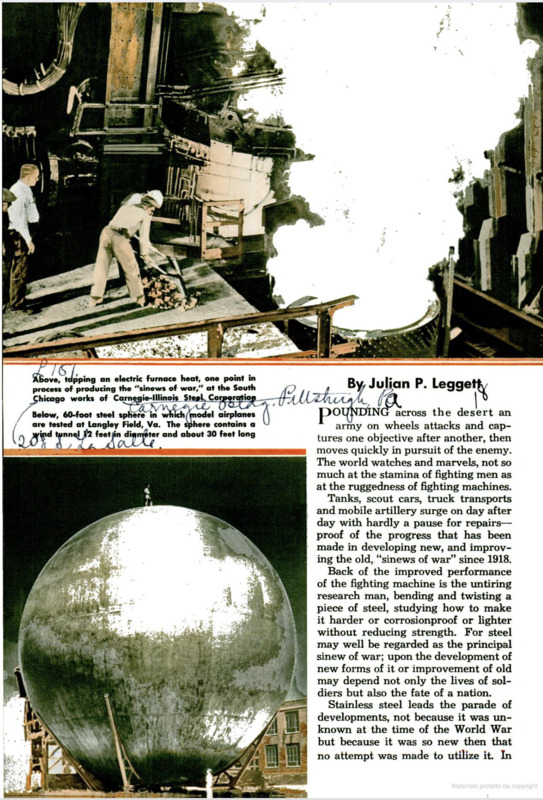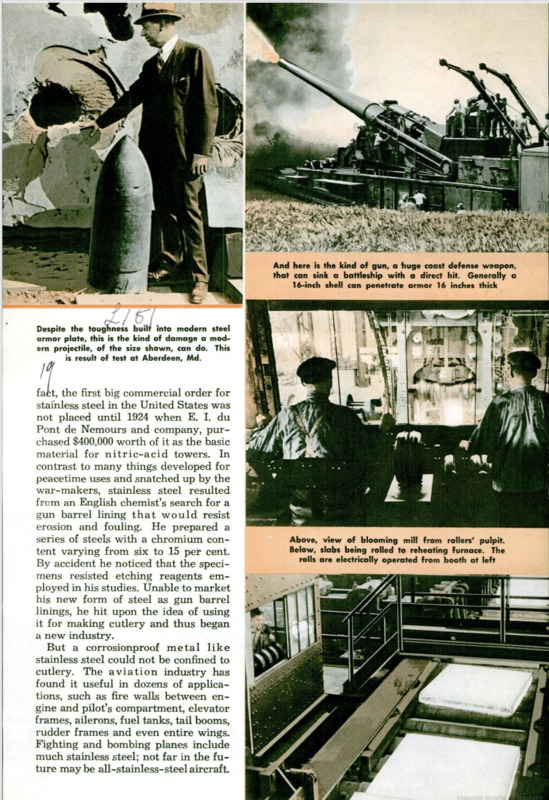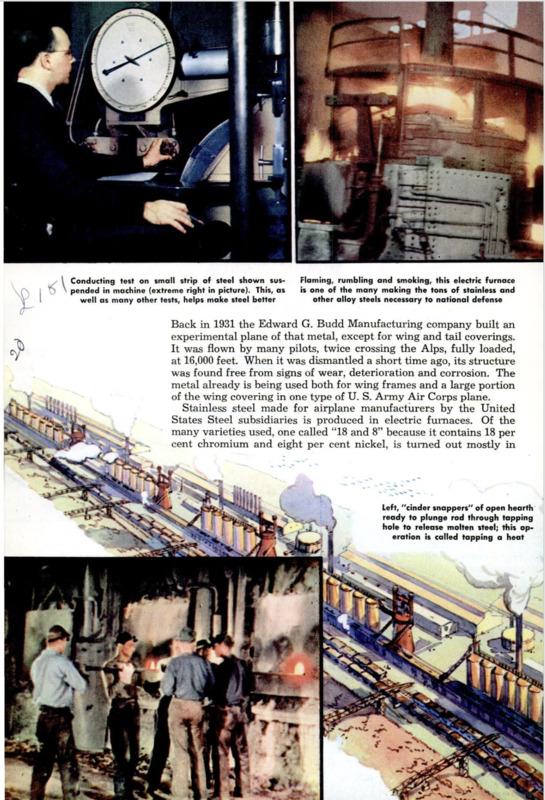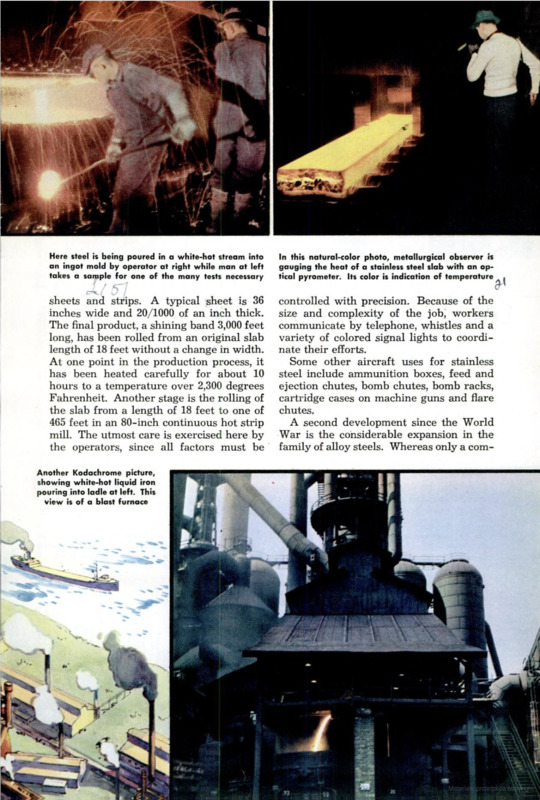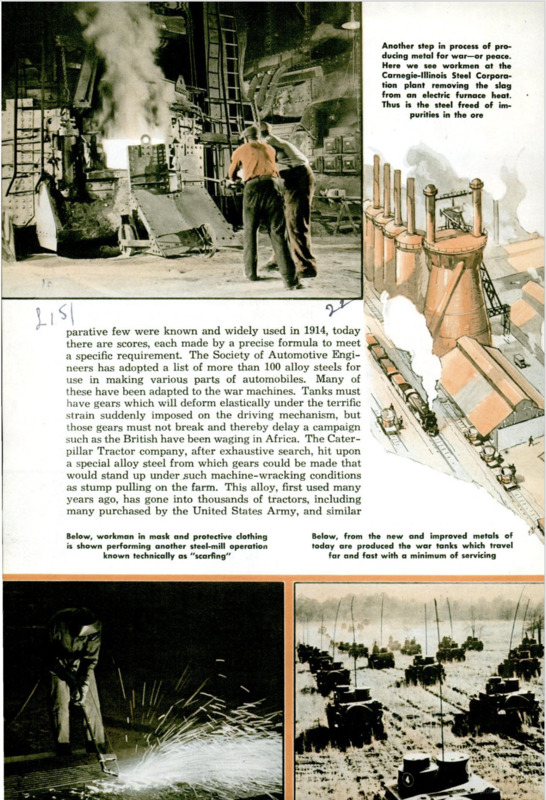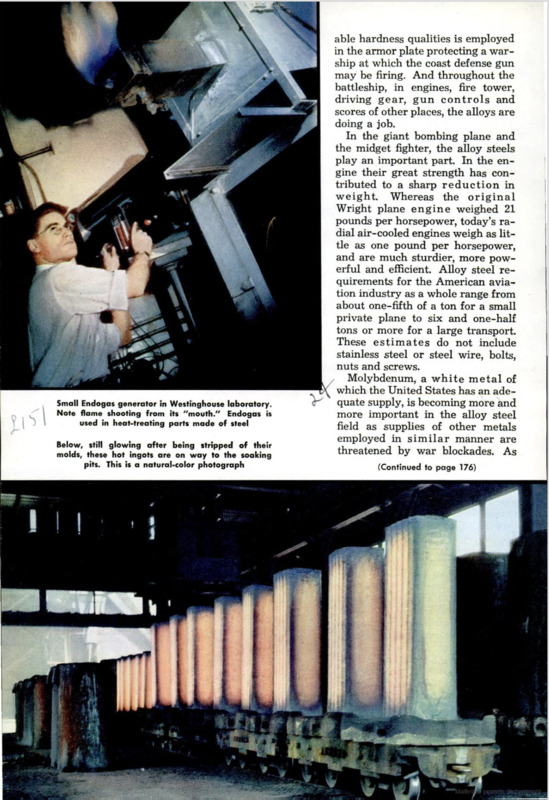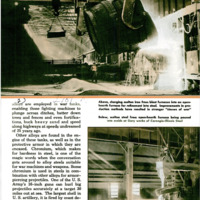POUNDING across the desert an army on wheels attacks and captures one objective after another, then moves quickly in pursuit of the enemy. The world watches and marvels, not so much at the stamina of fighting men as at the ruggedness of fighting machines. Tanks, scout cars, truck transports and mobile artillery surge on day after day with hardly a pause for repairs - proof of the progress that has been made in developing new, and improving the old, “sinews of war” since 1918. Back of the improved performance of the fighting machine is the untiring research man, bending and twisting a piece of steel, studying how to make it harder or corrosionproof or lighter without reducing strength. For steel may well be regarded as the principal sinew of war; upon the development of new forms of it or improvement of old may depend not only the lives of soldiers but also the fate of a nation. Stainless steel leads the parade of developments, not because it was unknown at the time of the World War but because it was so new then that no attempt was made to utilize it. In fatt, the first big commercial order for stainless steel in the United States was not placed until 1924 when E. L du Pont de Nemours and company, purchased $400,000 worth of it as the basic material for nitric-acid towers. In contrast to many things developed for peacetime uses and snatched up by the war-makers, stainless steel resulted from an English chemist’s search for a gun barrel lining that would resist erosion and fouling. He prepared a series of steels with a chromium content varying from six to 15 per cent. By accident he noticed that the specimens resisted etching reagents employed in his studies. Unable to market his new form of steel as gun barrel linings, he hit upon the idea of using it for making cutlery and thus began a new industry. But a corrosionproof metal like stainless steel could not be confined to cutlery. The aviation industry has found it useful in dozens of applications, such as fire walls between engine and pilot’s compartment, elevator frames, ailerons, fuel tanks, tail booms, rudder frames and even entire wings. Fighting and bombing planes include much stainless steel; not far in the future may be all-stainless-steel aircraft. Back in 1931 the Edward G. Budd Manufacturing company built an experimental plane of that metal, except for wing and tail coverings. It was flown by many pilots, twice crossing the Alps, fully loaded, at 16,000 feet. When it was dismantled a short time ago, its structure was found free from signs of wear, deterioration and corrosion. The metal already is being used both for wing frames and a large portion of the wing covering in one type of U. S. Army Air Corps plane. Stainless steel made for airplane manufacturers by the United States Steel subsidiaries is produced in electric furnaces. Of the many varieties used, one called “18 and 8" because it contains 18 per cent chromium and eight per cent nickel, is turned out mostly in sheets and strips. A typical sheet is 36 inches wide and 20/1000 of an inch thick. The final product, a shining band 3,000 feet long, has been rolled from an original slab length of 18 feet without a change in width. At one point in the production process, it has been heated carefully for about 10 hours to a temperature over 2,300 degrees Fahrenheit. Another stage is the rolling of the slab from a length of 18 feet to one of 465 feet in an 80-inch continuous hot strip mill. The utmost care is exercised here by the operators, since all factors must be controlled with precision. Because of the size and complexity of the job, workers communicate by telephone, whistles and a variety of colored signal lights to coordinate their efforts. Some other aircraft uses for stainless steel include ammunition boxes, feed and ejection chutes, bomb chutes, bomb racks, cartridge cases on machine guns and flare chutes. A second development since the World War is the considerable expansion in the family of alloy steels. Whereas only a comparative few were known and widely used in 1914, today there are scores, each made by a precise formula to meet a specific requirement. The Society of Automotive Engineers has adopted a list of more than 100 alloy steels for use in making various parts of automobiles. Many of these have been adapted to the war machines. Tanks must have gears which will deform elastically under the terrific strain suddenly imposed on the driving mechanism, but those gears must not break and thereby delay a campaign such as the British have been waging in Africa. The Caterpillar Tractor company, after exhaustive search, hit upon a special alloy steel from which gears could be made that would stand up under such machine-wracking conditions as stump pulling on the farm. This alloy, first used many years ago, has gone into thousands of tractors, including many purchased by the United States Army, and similar alloys are employed in war tanks, enabling those fighting machines to plunge across ditches, batter down trees and fences and even fortifications, buck heavy sand and speed along highways at speeds undreamed of 25 years ago. Other alloys are found in the engine of these tanks, as well as in the protective armor in which they are encased. Chromium, which makes for hardness in steel, is one of the magic words when the conversation gets around to alloy steels suitable for war machines and weapons. Some chromium is used in steels in combination with other alloys for armor-piercing projectiles. One of the U. S. Army’s 16-inch guns can hurl big projectiles accurately at a target 30 miles out at sea. The largest shell in U. S. artillery, it is fired by coast defense guns. This 16-inch projectile can penetrate 16 inches of steel before its mighty charge sends pieces of its heavy steel body with such force in all directions that one direct hit can cause damage sufficient to sink any existing battleship. Similarly, alloy steel with desirable hardness qualities is employed in the armor plate protecting a warship at which the coast defense gun may be firing. And throughout the battleship, in engines, fire tower, driving gear, gun controls and scores of other places, the alloys are doing a job. In the giant bombing plane and the midget fighter, the alloy steels play an important part. In the engine their great strength has contributed to a sharp reduction in weight. Whereas the original Wright plane engine weighed 21 pounds per horsepower, today’s radial air-cooled engines weigh as little as one pound per horsepower, and are much sturdier, more powerful and efficient. Alloy steel requirements for the American aviation industry as a whole range from about one-fifth of a ton for a small private plane to six and one-half tons or more for a large transport. These estimates do not include stainless steel or steel wire, bolts, nuts and screws. Molybdenum, a white metal of which the United States has an adequate supply, is becoming more and more important in the alloy steel field as supplies of other metals employed in similar manner are threatened by war blockades. As far back as 1925 this metal has become recognized as a good substitute for tungsten in tool steels and as an alloying element in structural steels. Since 1925 its use in carbon and alloy steels has increased. Dr. M. A. Grossman, director of research, Carnegie-Illinois Steel Corporation, points out that back of the strenuous role which steel plays in present day equipment is a vastly greater knowledge of each step in manufacture than was available years ago. Too, control of every operation is more precise, resulting in a superior product. Both of these have resulted from research conducted for the most part on peacetime uses of steel. Three of the most important studies now in progress are those on toughness, heat treatment and grain size of steel. Toughness in high-strength steels is extremely important in the war machine and weapon, as well as to the automobile and farm implement makers, to railroads and to many other users. Research men have found that the shape of the structural member has an influence on its toughness and have developed tests to study this effect. The extent to which a steel is hard- ened by heat treatment is termed its hard-enability. More fundamental is the research being done on grain size. The metallurgists have discovered that the grain size of steel may be altered by various treatments and that certain desirable qualities may be achieved in this manner. Rolling steel in the cold state is one means.of producing a finer grained, more workable steel than that which is produced by other processes. Steel men assert that the art of steel making has been revolutionized since the carly twenties. New products have been developed; the quality of others has been radically improved so that they are now actually new materials, although called by the same names. These improvements in the finished steel product have required basic changes in steel making, starting with the raw materials and moving steadily through the making of pig iron, steel ingots and each step of the finishing process. The quality of steel now produced in the open-hearth furnaces is a far superior product, definitely suited to the everchanging and more exacting process. Blast furnaces now produce a better pig iron by scientific grading and mixing of the ores and where necessary the crushing and sizing of the ores, coke and limestone that go into the pig-iron-making process. The open-hearth plant has become a process laboratory where the steel made is now produced scientifically by slag control, temperature control and control of the ingredients going into the steel. Uniform qualities of steel and uniform heat and other treatments required through fabrication of the finished article is facilitated by being able to secure steel in which the grain structure is controlled. As evidence of the improvement in basic steel properties, building codes today permit the use of a 20,000-pound per square inch stress, where two to four years ago it was 18,000 pounds and previously 16,000. Automobile fenders may now be pressed with as much as 18 inches of crown, where 20 years ago two or three inches was the maximum. In a related field, the heat treating of small manufactured parts, Westinghouse engineers have developed a gas which is regarded as the solution to one of the major problems in heat treating - the hardening of steels without softening or scaling at the surface. The gas, called Endogas, is used as a protective .atmosphere for furnaces and it is now at work in all the major airplane engine and accessory plants turning out thousands of parts such as shafts, gears and bolts. Not only does Endogas counteract destructive gases that soften steel surfaces in heat treating, but it also saves time and money because it eliminates the necessity of machining steel parts after they have been hardened. Other companies have developed combinations of gases or methods for use in scale-free heat treatment. Rapid strides in the science of steel making have had, and will continue to have a profound effect not only upon the manner in which modern warfare is waged, but also upon the national economy. They have made possible the development of natural resources, the newer progress of transportation, the better preparation and preservation of foods, more economical construction of modern plant and office buildings, better roads, better agricultural buildings, improved modern airplane construction and have made contributions in innumerable other fields.
